UNDERFLOOR HEATING SYSTEMS
Everything You Need to Know
UNDERFLOOR HEATING SYSTEMS
Everything You Need to Know
Introduction
If you’re thinking about installing an underfloor heating system, it’s essential to do your research first to check which type of underfloor heating is best for your needs.
In this guide, we tell you everything you need to know about underfloor heating systems: how they work, electric vs water underfloor heating, the costs involved, installation, and what you need to consider before buying an underfloor heating system.
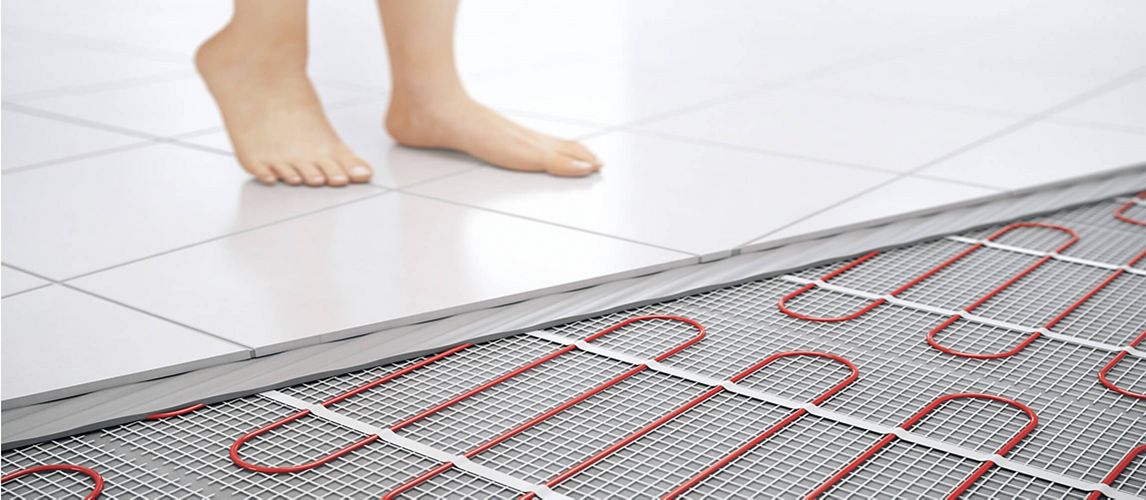
How Does Underfloor Heating Work?
There are two types of underfloor heating: electric and warm water. Both work in a similar way. A network of pipes (for warm water systems) or electric cables (for electric systems) are laid under the floor. When the system is switched on, the pipes or cables warm up and heat the floor’s surface, providing radiant heat that warms the room from the ground up.
Electric or Water Underfloor Heating?
Deciding whether to install electric or water underfloor heating depends on the property and the homeowner’s preferences.
Let’s take a closer look at the two types of underfloor heating and why you might choose one over the other.
Electric Underfloor Heating Systems
Electric underfloor heating - how it works
In electric underfloor heating, heating mats are laid under the floor. The mats consist of heated cables that are embedded onto a mesh mat with self-adhesive backing.
The heating mats are placed on top of a screed (sand and cement) layer to ensure the surface is even. And then a layer of insulation to ensure the heat travels upwards instead of down. They are then covered with the chosen flooring.
Once laid, the heating wires are connected to the mains electric and are controlled with a thermostat and programmer.
Electric vs water underfloor heating
Electric underfloor heating is cheaper to buy than water underfloor heating, and it’s also easier to fit. However, as electricity is less efficient at heating than gas, the running costs are much higher. For this reason, people often opt to only install it in small rooms, such as bathrooms, rather than using it to heat a whole property.
Things to consider when buying electric underfloor heating
When buying electric underfloor heating, choosing a system with the correct wattage for your needs is vital. Systems range from around 100-200W per square metre and run at approximately 25-31ºC.
The wattage needed will depend on the size of the room, how well insulated it is and the flooring type used below and above the heat mats. So, for example, a small, well-insulated room with good heat conducting flooring, such as ceramic or stone, will need low wattage heat mats. On the other hand, a large, draughty room with poor heat conducting flooring, like carpet, will require higher wattage heat mats to reach the same level of warmth.
Electric underfloor heating installation
One of the advantages of electric underfloor heating is that it can be installed by an experienced DIYer or tradesperson. However, connecting the heat mats to the mains electric is a specialist job that must be carried out by a qualified electrician.
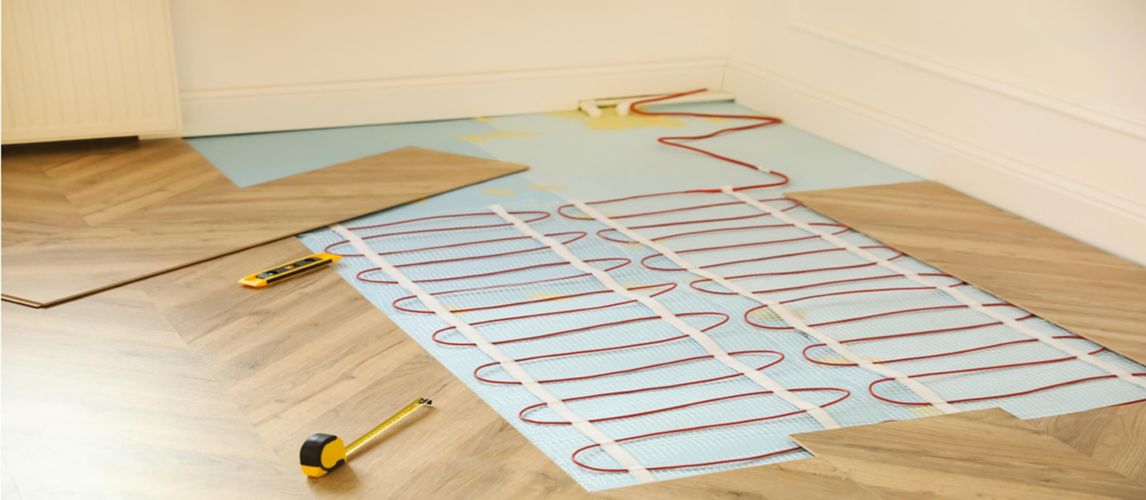
Warm Water Underfloor Heating Systems
Warm water underfloor heating- how it works
Warm water underfloor heating is also known as ‘wet’ underfloor heating. This system has a series of flexible polyethylene pipes under the floor, held in place by plastic clips.
The pipes are placed on top of a layer of insulation to ensure the heat travels upwards and is then covered with screed (sand and cement) to ensure the surface is even. It’s then covered with the chosen flooring.
Once laid, the pipes are connected to a device called a manifold, which is connected to the boiler and heating system. Warm water is pumped around the underfloor pipes in the same way that it’s pumped around radiators. It’s then all controlled with a thermostat and programmer.
Warm water underfloor heating is compatible with any fuel heating system, including gas, LPG, solar heating panels and heat pumps.
Benefits of using underfloor heating with heat pumps
Powering an underfloor heating system with a heat pump is up to 40% more efficient than using a boiler and radiator system. This is because heat pumps deliver lower temperatures than traditional heating methods. And as wet underfloor heating uses water that’s around 40-45°C (compared to radiators, which work at 70-80°C), heat pumps and underfloor heating are highly compatible. Heat pumps are also great for the environment, emitting zero carbon when used with a renewable electricity supplier. In addition, they lower energy bills, and their installation cost can be offset by Renewable Heat Incentive payments.
Water vs electric underfloor heating
Water underfloor heating is more expensive to buy than electric underfloor heating. It can also be more difficult to install, particularly if it’s being retrofitted into a property. It needs more space than electric systems, so retrofitting could mean digging up floors or raising the floor height, which will have a knock-on effect on doors in the room. For this reason, water underfloor heating is easier to install into new builds as the pipes can be installed before the final floor is laid.
On the plus side, water-based central heating systems are more efficient at heating than electric-based systems. So, although initial installation may be more, the savings on running costs make water underfloor heating a cheaper option in the long term.
Things to consider when buying warm water underfloor heating
When buying warm water underfloor heating, it’s vital to ensure the system will meet the home’s heating needs. This is because these systems run at lower temperatures than radiators – usually between 27-31ºC. And the heat output will depend on the size of the room, how well insulated it is, the depth of the screed and the flooring type used below and above the pipes.
So, for example, a small well-insulated room with good heat conducting flooring will reach warmer temperatures than a large, draughty room with poor heat conducting flooring.
Warm water underfloor heating installation
Warm water underfloor heating installation is a job for a qualified heating engineer. It involves plumbing work, the installation of a manifold, plus connecting the whole system up to the boiler or other heating system and testing it. And any work on boilers must always be carried out by a registered Gas Safe engineer.
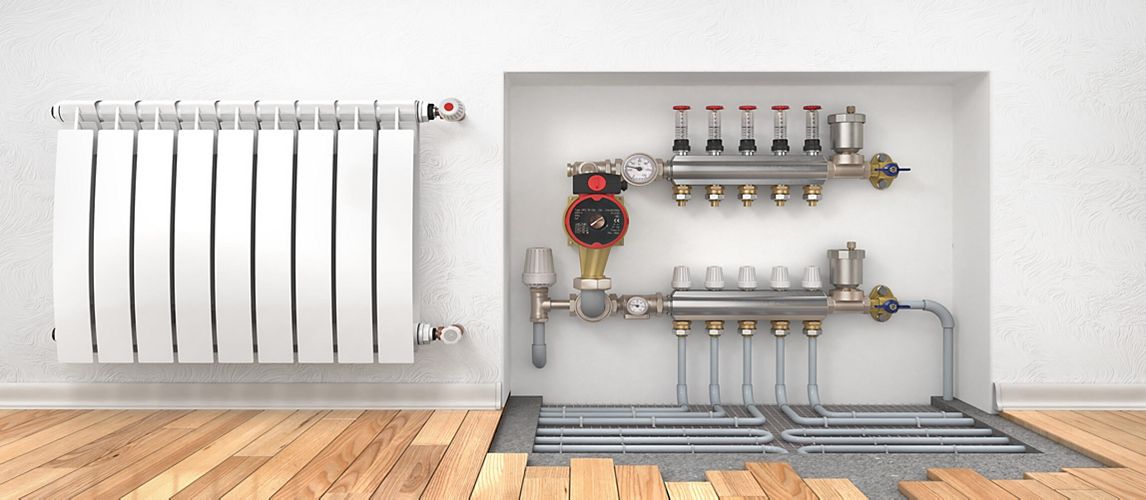
What is The Best Underfloor Heating For Me?
To choose the best underfloor heating system for your needs, weigh up the following:
-
The available fuel type - water underfloor heating can only be installed with gas/LPG central heating, a heat pump, or solar heating panels.
-
The size of the room - small rooms are less expensive to heat with electricity, whereas it would be costly to heat large rooms.
-
The insulation - homes must be adequately insulated to ensure underfloor heating works well, whichever system you choose.
-
The installation - electric is easier and less costly to retrofit into existing homes. Water underfloor heating suits new builds better.
How Much is Underfloor Heating
The price you pay for underfloor heating will vary depending on the type you choose and how and where it will be installed.
Electric underfloor heating costs less to buy than water underfloor heating. You’ll then need to factor in costs for any other materials such as insulation and screed. And when it comes to installation, electric systems will cost less than water systems because there is less work involved.
Advantages of Underfloor Heating
- It provides comfortable heat underfoot
- It distributes heat more evenly than radiators and electric heaters, so there are no hot spots or cold draughts
- You can divide the property into zones and control each zone independently
- No radiators on the walls saves space and allows furniture to be placed anywhere
- It reduces the circulation of dust, meaning the air is cleaner and less allergenic.
Disadvantages of Underfloor Heating
- Installation can be expensive and disruptive – particularly for water underfloor heating and particularly if it’s retrofitted
- Underfloor heating works at lower temperatures than radiators and therefore takes longer to heat up a room
- Electric underfloor heating is expensive to run in large rooms
- The choice of flooring is restricted.
Underfloor Heating Installation
Electric underfloor heating installation
Electric underfloor heating can be installed by any competent DIYer or tradesperson. But all electrical work, including wiring and connecting the underfloor heating, thermostat, and programmer to the mains electric, must be completed by a qualified electrician who is part P or NICEIC certified.
Professional underfloor heating companies can also do the work for you. One benefit is that many offer guarantees or warranties that cover the system should anything go wrong later down the line.
Installing electric underfloor heating takes around one to two days when you factor in the time it takes for the screed to dry. The room will be out of use while the work is carried out, and the electricity will need to be turned off when the system is connected to the mains.
Wet underfloor heating installation
We recommend wet underfloor heating be installed by a qualified plumber or heating engineer. If the system is being connected to a boiler, then the final connection must be completed by a certified Gas Safe engineer. There is also some electrical work involved to connect the system to a thermostat and programmer. Again, this must be carried out by a qualified electrician who is part P or NICEIC certified.
Installing water underfloor heating is a complex job, and the amount of time it takes can vary depending on the amount of work involved to prepare the base. Installing it into a new build before any final flooring has already been laid will be much quicker than retrofitting it. But as a general guide, you can expect it to take at least two days. The room will be out of use while the work is carried out, and the electricity and gas will need to be turned off when the system is connected to the mains.
Underfloor Heating Equipment
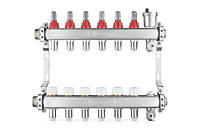
Underfloor heating manifolds
Underfloor heating manifolds are the hub for water underfloor heating systems. They are where all the underfloor heating pipes meet and where the supply of hot water from the heat source, such as a boiler, is fed. They also manage the water flow rate, temperature, and pressure.
The size and type of manifold needed for underfloor heating depends on the number of rooms or zones that need to be connected. A manifold comprises of between 2-12 ports (where the pipes connect) that work in pairs. You need one pair of ports for every room or zone.
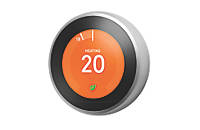
Thermostats
With underfloor heating, a thermostat can be installed into every room or heating zone instead of only having one thermostat to control the whole property. This allows each room to be controlled independently.
There are a few types of thermostats available, such as simple dial thermostats, thermostats with digital displays and smart thermostats that can be controlled from a phone or tablet. There are also programmable thermostats that control the times the underfloor heating switches off and on.
3 Considerations When Getting Underfloor Heating
It’s always important to do your research before buying underfloor heating to ensure you’re getting the right product for the room it’s needed for and that it will heat a room sufficiently.
Here are five things to consider:
1. Property type
Water underfloor heating systems are much easier to install if they have been planned into the building’s design. For example, the height of the floor to accommodate the pipes can be taken into consideration, and they can be laid before the final floor is fitted.
If the underfloor heating system is retrofitted, electricity can be easier because it's laid on the existing floor without raising the floor height too much. It is still possible to retrofit water underfloor heating, but either the existing base will need to be dug out to accommodate the size of the bulky pipes, or it can be laid on top of the existing floor, which will raise the floor height. That will have a knock-on effect on skirting boards and the height of the doors in the home.
New builds are also subject to strict building regulations when it comes to insulation. So, you’ll know the underfloor heating system will work effectively in a new build. An older home, on the other hand, may need to have its insulation upgraded.
2. Best flooring for underfloor heating
Most types of flooring are fine to use with underfloor heating. But some types work better than others. It all depends on how well they conduct heat. So, which is the best flooring for underfloor heating?
Flooring below underfloor heating
The floor below underfloor heating is just as important as the flooring that goes on top of it. If you get this wrong, heat can be absorbed into the floor rather than radiated out into the room.
For underfloor heating on concrete floors, apply a layer of damp-proof membrane first, then install insulation boards on top. For underfloor heating on suspended timber floors, a damp-proof membrane isn’t needed.
Engineered wood flooring for underfloor heating
Engineered wood is seen as one of the best underfloor heating wooden floor options to choose because it performs well with shifting temperatures. Solid wood works too. But engineered wood, consisting of a solid wood top layer, has added base layers that give it strength and stability. Look for engineered wood boards with a 150mm depth. It warms up quickly and stays warm long after the heating has been switched off.
Real wood flooring for underfloor heating
Real wood works well with underfloor heating. First, check what the maximum temperature the wood can take is. It needs to be able to be heated to 27ºC to be compatible with underfloor heating. Otherwise, the wood can warp, shrink or discolour. The timber also needs to be well-seasoned or kiln-dried.
And be careful with rugs. A rug can trap heat and cause damage to the floor.
Laminate flooring for underfloor heating
Laminate flooring is suitable for use with underfloor heating, but the floor shouldn’t be heated to more than 27ºC to protect it from damage.
To maximise heat transfer, you should look for laminate flooring that’s no thicker than 18mm. Anything thicker will slow down heat transfer, making the room take longer to warm up.
Stone and ceramic tiles for underfloor heating
Stone and ceramic tiles are the best heat conductors over all other flooring types, making them ideal for underfloor heating. They heat up very quickly and retain their heat long after the system has been switched off.
Luxury vinyl tiles for underfloor heating
Vinyl flooring works well with underfloor heating because heat can easily filter through its thin surface. But always check the manufacturer’s recommendations because a lot of vinyl can’t be heated above 26ºC. That temperature is acceptable, but if vinyl is used, the underfloor heating system must be set up to ensure it doesn’t go any higher than that.
Carpet for underfloor heating
Carpet can be used with underfloor heating, but it’s probably the least effective out of all the floor types because it will take a long time for the heat to get through. And it will cool down again very quickly once the system is switched off.
To get the best result when using carpet, keep the combined tog rating of the carpet and underlay to below 2.5 and ideally below 1.5.
3. Replacing radiators and heating system
When installing underfloor heating, it’s important to consider how it will work with the current heating system.
Underfloor heating working alongside the current heating system
Both types of underfloor heating can work alongside the current heating system. For example, just in the bathroom, extension, conservatory or loft conversion, or as an additional heat source alongside existing radiators or electric heaters.
If underfloor heating will be working alongside your current heating system, you need to consider:
- The boiler – does it have enough power to heat and pump the extra water for the underfloor heating.
- The current radiators – these may need to be changed to have a lower heat output. Or thermostatic radiator valves can be added so the temperature can be regulated. Check out our radiator buying guide for more information.
Underfloor heating instead of the current heating system
If underfloor heating will be the only source of heating for a home, and there is currently a central heating system, then it’s important to consider the work involved to remove the old system on top of installing the new system. The work may involve:
- Removing radiators or electric heaters
- Disconnecting and removing water pipes or electrical cables
- Filling holes in the walls where the brackets have been removed
- Decorating the room.
How Efficient is Underfloor Heating
Underfloor heating efficiency depends on many factors, such as the size of the room, how well insulated the home is, and the type of flooring that’s used.
Water underfloor heating systems are more efficient alternatives to radiators because heat is emitted more evenly around the room than with a single radiator. The heat also comes from a larger surface area, which means it can work with water at lower temperatures. Typically water underfloor heating uses 15-40% less energy than radiators.
Electric underfloor heating is less efficient than water underfloor heating because electricity is less efficient at heating than gas. This means electric underfloor heating running costs are higher. However, it’s a more efficient way of heating a single, small room because it can be used independently, without heating the whole property.
